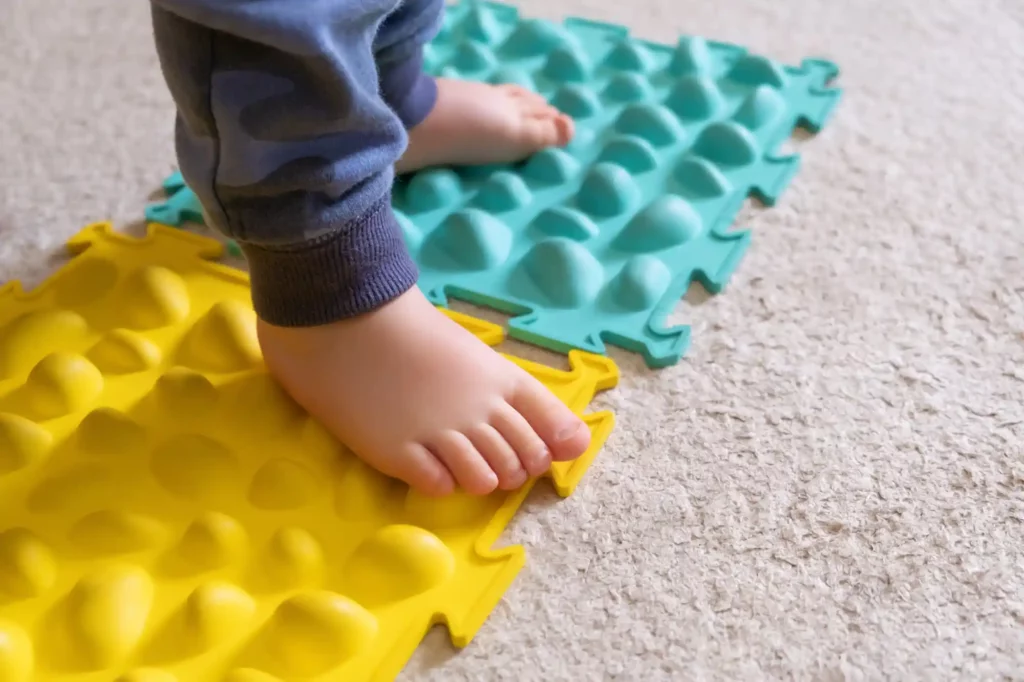We have all heard that we have 5 senses. Touch, taste, sight, smell, and hearing. Each of these senses brings us important information. For example, TOUCH helps you know the difference between the feel of a butterfly landing on your arm and the feel of a friend tapping you on your shoulder. Apart from these commonly known 5 senses, did you know that we have 2 more senses – Vestibular and Proprioception? These senses help with movement.
Proprioception is sensed by our joints and helps us know where our body is in space. It helps you do activities like walking upstairs without having to look down at your feet. This sense also tells us how much force to use when doing things like drinking water from a disposable glass, or picking up and cracking an egg. Vestibular sense is sensed by the inner ear and tells us whether we are balanced. This sense helps us move our body without falling so we can do activities like walking, riding a bicycle, etc.
All the above-mentioned senses work together through a process called sensory integration. Sensory integration makes it possible to learn, play, socialize, and generally perform all functions. Putting together information from all these different senses makes it possible for us to participate in daily activities and interact with the world successfully. However, some children may find it difficult to process this information from the senses and respond accordingly. This is where sensory integration comes into play.
What is sensory integration therapy?
Sensory integration is a term that is used to describe processes in the brain that allow us to take in the information we receive from our senses, organize it and respond appropriately. Sensory integration therapy is designed to help individuals with sensory processing problems through activity/play-oriented approach and may include equipment like swings, trampolines, and slides
Effectiveness of Sensory Integration Therapy
Sensory integration therapy has been used for over many years. With sensory integration therapy, your child will be able to interact with the environment better. Besides normalizing sensory issues, sensory integration therapy also helps to improve your child’s cognitive functions, sitting tolerance and social skills.

What is sensory integration therapy used for?
Sensory integration therapy is used to minimize sensory difficulties which are common in ASD, ADHD, and other disorders like sensory processing disorder.
What does sensory integration therapy involve?
Sensory integration therapy helps children learn to use all their senses together, that is smell, taste, touch, sight, hearing, movement and pressure by introducing different sensory stimuli like swing, trampoline, music, lights etc. For example activities like swinging, running in the park, jumping, etc. can be prescribed for a child who is a movement seeker/ craves movement.
Does sensory integration therapy help autistic children?
Children with autism may have difficulty processing the information they receive from the senses we have discussed earlier. Some children may be seekers i.e., their body craves for certain sensory stimuli like movement, pressure, vision or sound. Whereas others may avoid these kinds of sensory stimuli. They may not tolerate loud noises or bright lights. Sensory integration therapy helps children on the spectrum to better organize the sensory information received from the environment to overcome their sensory issues and help them function better in their life, thereby improving their quality of life.
Where does sensory integration therapy come from?
Anna Jean Ayres, an occupational therapist and educational psychologist developed sensory integration therapy for children with sensory processing difficulties. She was also an advocate for individuals with special needs.
Sensory Integration Therapy Benefits
As discussed above, sensory integration therapy helps to normalize sensory difficulties in individuals. Listed below are the other benefits of sensory integration therapy.
- Improve independence in daily activities
- Organize sensory information
- Improve cognitive functions
- Improve sitting tolerance by channelizing their energy
- Improve function in school, home and community
How is the treatment done?
The treatment is done by exposing children to various sensory stimulation in a structured and repetitive manner. For example, brushing on the body, introducing different textured mats, etc. can be given in a repetitive manner for a child who is a tactile seeker/ craves touch. Also, for a child who avoids tactile input/touch, the stimuli that we introduce are the same. But the amount of stimuli and how we introduce the stimuli is different, i.e., you may start with soft brushes and then slowly you can use rough brushes. However, before taking up sensory integration therapy for your child, it is best to consult a qualified occupational therapist in order to avoid overstimulation or under-stimulation and ensure appropriate treatment for your child.
Who is eligible for the treatment? (When is the treatment done?)
Children with sensory processing disorder(SPD) alone or SPD associated with ASD, ADHD and other disorders including genetic disorders are eligible for this treatment
How long does it take to recover?
Every child is different and unique, so establishing a definite recovery time may not be possible. The way each child interacts with the environment, family members, and peer groups is different.
With sensory integration, your child may show improvement in various areas of their life. Definitely, your child will be able to process sensory information and integrate them better to perform their daily activities. Some kids may recover from it completely, whereas some kids may have it lifelong but learn to cope with it through sensory integration interventions. The idea is that with sensory integration a child will be able to better process and adapt in accordance with their sensory needs.
FAQ
For a child who is a pressure seeker, activities may include animal walks, jumping, hanging on the monkey bar, etc.
To use sensory integration therapy at home, it is best to consult an occupational therapist first, who can provide you with an appropriate home program that can be followed at home.
Sensory integration therapy helps children to learn to use all their senses together.
Sensory integration therapy helps children by normalizing their sensory issues and thereby teaching them to use all their senses appropriately.
- Improve independence in daily activities
- Organize sensory information
- Improve cognitive functions
- Improve sitting tolerance by channelizing their energy
- Improve function in school, home and community


